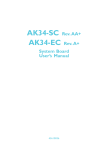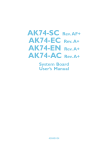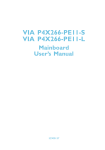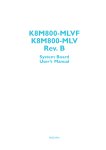Download DFI PT800-AL Motherboard
Transcript
Addendum The PT880-ALF system board supports two IEEE 1394 ports. It is equipped with an IEEE 1394 port at the rear I/O panel and a 10-pin connector at location J8 for connecting an additional IEEE 1394 port. All other information in this manual pertains to the PT880-ALF too. Please refer to this manual for reference. 1/1 936-PT8806-300 79101418 PT880-AL PT800-AL Rev. A+ System Board User’s Manual 79100349 Copyright This publication contains information that is protected by copyright. No part of it may be reproduced in any form or by any means or used to make any transformation/adaptation without the prior written permission from the copyright holders. This publication is provided for informational purposes only. The manufacturer makes no representations or warranties with respect to the contents or use of this manual and specifically disclaims any express or implied warranties of merchantability or fitness for any particular purpose. The user will assume the entire risk of the use or the results of the use of this document. Further, the manufacturer reserves the right to revise this publication and make changes to its contents at any time, without obligation to notify any person or entity of such revisions or changes. © 2004. All Rights Reserved. Trademarks Windows® 98, Windows® 98 SE, Windows® ME, Windows® 2000, Windows NT® 4.0 and Windows® XP are registered trademarks of Microsoft Corporation. Intel®, Pentium® 4 and Celeron are registered trademarks of Intel Corporation. VIA is a registered trademark of VIA Technologies, Inc. Award is a registered trademark of Award Software, Inc. Other trademarks and registered trademarks of products appearing in this manual are the properties of their respective holders. Caution To avoid damage to the system: • Use the correct AC input voltage range.. To reduce the risk of electric shock: • Unplug the power cord before removing the system chassis cover for installation or servicing. After installation or servicing, cover the system chassis before plugging the power cord. Battery: • Danger of explosion if battery incorrectly replaced. • Replace only with the same or equivalent type recommend by the manufacturer. • Dispose of used batteries according to the batter y manufacturer’s instructions. FCC and DOC Statement on Class B This equipment has been tested and found to comply with the limits for a Class B digital device, pursuant to Part 15 of the FCC rules. These limits are designed to provide reasonable protection against harmful interference when the equipment is operated in a residential installation. This equipment generates, uses and can radiate radio frequency energy and, if not installed and used in accordance with the instruction manual, may cause harmful interference to radio communications. However, there is no guarantee that interference will not occur in a particular installation. If this equipment does cause harmful interference to radio or television reception, which can be determined by turning the equipment off and on, the user is encouraged to try to correct the interference by one or more of the following measures: • Reorient or relocate the receiving antenna. • Increase the separation between the equipment and the receiver. • Connect the equipment into an outlet on a circuit different from that to which the receiver is connected. • Consult the dealer or an experienced radio TV technician for help. Notice: 1. The changes or modifications not expressly approved by the party responsible for compliance could void the user's authority to operate the equipment. 2. Shielded interface cables must be used in order to comply with the emission limits. Notice This user’s manual contains detailed information about the system board. If, in some cases, some information doesn’t match those shown in the multilingual manual, the multilingual manual should always be regarded as the most updated version. The multilingual manual is included in the system board package. To view the user’s manual, insert the CD into a CD-ROM drive. The autorun screen (Main Board Utility CD) will appear. Click “User’s Manual”. System Board This user’s manual is for the PT880-AL and PT800-AL system boards. The only difference between these boards is the PT880AL system board supports dual channel memory interface. Table of Contents Chapter 1 - Introduction 1.1 Features and Specifications................................................................................. 7 1.2 Hyper-Threading Technology Functionality Requirements... 14 1.3 Package Checklist........................................................................................................... 14 Chapter 2 - Hardware Installation 2.1 2.2 2.3 2.4 2.5 2.6 System Board Layout ........................................................................................... System Memory........................................................................................................... CPU........................................................................................................................................ Jumper Settings............................................................................................................. Rear Panel I/O Ports.............................................................................................. I/O Connectors........................................................................................................... 15 16 19 24 26 37 Chapter 3 - BIOS Setup 3.1 Award BIOS Setup Utility.................................................................................... 46 3.2 VIA RAID BIOS Setting Utility........................................................................ 87 3.3 Updating the BIOS..................................................................................................... 88 Chapter 4 - Supported Softwares 4.1 4.2 4.3 4.4 Desktop Management Interface..................................................................... 90 Drivers, Utilities and Software Applications......................................... 93 3D Audio Configuration........................................................................................103 Installation Notes..........................................................................................................104 1 Introduction Appendix A - Enabling the Hyper-Threading Technology A.1 Enabling the Hyper-Threading Technology........................................... 105 Appendix B - Using the Suspend to RAM Function B.1 Using the Suspend to RAM Function................................................... 108 Appendix C - System Error Messages C.1 POST Beep.................................................................................................................... 112 C.2 Error Messages........................................................................................................... 112 Appendix D - Troubleshooting D.1 Troubleshooting Checklist................................................................................. 114 6 Introduction 1 Chapter 1 - Introduction 1.1 Features and Specifications 1.1.1 Features Chipset • PT880-AL - North bridge: VIA® PT880 Advanced high performance 128-bit DDR DRAM controller - South bridge: VIA® VT8237 • PT800-AL - North bridge: VIA® PT800 - South bridge: VIA® VT8237 Processor The system board is equipped with Socket 478 for installing one of the following supported processors. • Intel® Pentium® 4 (Prescott and Northwood) processor up to 3.06GHz - Intel Hyper-Threading Technology - FSB: 533MHz and 800MHz • Intel® Celeron® processor - 400MHz system data bus System Memory • Suppor ts dual channel (128-bit wide) memor y interface (PT880-AL only) • Three 184-pin DDR DIMM sockets • Suppor ts up to 3GB using PC1600 (DDR200), PC2100 (DDR266), PC2700 (DDR333) and PC3200 (DDR400) unbuffered DDR SDRAM DIMM, 2.6V type DIMMs 2MBx64 4MBx64 8MBx64 Memory Size 16MB 32MB 64MB DIMMs 16MBx64 32MBx64 64MBx64 Memory Size 128MB 256MB 512MB 7 1 Introduction Expansion Slots • 1 AGP slot • 5 PCI slots AGP (Accelerated Graphics Port) AGP is an interface designed to support high performance 3D graphics cards. It utilizes a dedicated pipeline to access system memory for texturing, z-buffering and alpha blending. The universal AGP slot supports AGP 8x with up to 2133MB/sec. bandwidth and AGP 4x with up to 1066MB/sec. bandwidth for 3D graphics applications. AGP in this system board will deliver faster and better graphics to your PC. Onboard Audio Features • AC’97 2.2 extension compliant codec • Supports Microsoft® DirectSound/DirectSound 3D • AC’97 supported with full duplex, independent sample rate converter for audio recording and playback • S/PDIF-in/out compressed digital output • 6-channel audio output via software S/PDIF S/PDIF is a standard audio file transfer format that transfers digital audio signals to a device without having to be converted first to an analog format. This prevents the quality of the audio signal from degrading whenever it is converted to analog. S/PDIF is usually found on digital audio equipment such as a DAT machine or audio processing device. The S/PDIF connector on the system board sends surround sound and 3D audio signal outputs to amplifiers and speakers and to digital recording devices like CD recorders. 6-channel Audio The audio jacks at the rear panel will support 6-channel audio only when the audio utility is configured to support this function. The micin at the rear will be disabled. Use the front audio’s mic-in jack. 8 Introduction 1 Onboard LAN Features • Phy fast ethernet controller • Integrated IEEE 802.3, 10BASE-T and 100BASE-TX compatible PHY • 32-bit PCI master interface • Integrated power management functions • Full duplex support at both 10 and 100 Mbps • Supports IEEE 802.3u auto-negotiation • Supports wire for management Serial ATA (SATA) IDE Interface with RAID Serial ATA is a storage interface that is compliant with SATA 1.0 specification. With speed of up to 1.5Gbps, it improves hard drive performance even in data intensive environments such as audio/ video, consumer electronics and entry-level servers. • Two SATA (Serial ATA) interfaces which are compliant with SATA 1.0 specification (1.5Gbps interface) • Supports RAID 0, RAID 1 and JBOD IEEE 1394 Interface (optional) • VIA VT6307 PCI 1394 integrated host controller • Supports two 100/200/400 Mb/sec ports IEEE 1394 is fully compliant with the 1394 OHCI (Open Host Controller Interface) 1.1 specification. It supports up to 63 devices that can run simultaneously on a system. 1394 is a fast external bus standard that supports data transfer rates of up to 400Mbps. In addition to its high speed, it also supports isochronous data transfer which is ideal for video devices that need to transfer high levels of data in real-time. 1394 suppor ts both Plug-and-Play and hot plugging. PCI Bus Master IDE Controller • Supports ATA/33, ATA/66, ATA/100 and ATA/133 hard drives • UDMA Modes 3, 4, 5 and 6 Enhanced IDE (data transfer rate up to 133MB/sec.) • Bus mastering reduces CPU utilization during disk transfer • Supports ATAPI CD-ROM, LS-120 and ZIP 9 1 Introduction USB Ports The system board supports USB 2.0 and USB 1.1. USB 1.1 supports 12Mb/second bandwidth while USB 2.0 supports 480Mb/ second bandwidth providing a marked improvement in device transfer speeds between your computer and a wide range of simultaneously accessible external Plug and Play peripherals. BIOS • Award BIOS, Windows ® 98/2000/ME/XP Plug and Play compatible • Supports SCSI sequential boot-up • Supports DMI 2.0 function • 4Mbit flash memory Desktop Management Interface (DMI) The system board comes with a DMI 2.0 built into the BIOS. The DMI utility in the BIOS automatically records various information about your system configuration and stores these information in the DMI pool, which is a part of the system board's Plug and Play BIOS. DMI, along with the appropriately networked software, is designed to make inventory, maintenance and troubleshooting of computer systems easier. Refer to chapter 4 for instructions on using the DMI utility. Rear Panel I/O Ports (PC 99 color-coded connectors) • • • • • • • • • 10 One PS/2 mouse port One PS/2 keyboard port One DB-9 serial port One DB-25 parallel port 2 S/PDIF RCA jacks (S/PDIF-in and S/PDIF-out) Four USB 2.0/1.1 ports One RJ45 LAN port One IEEE 1394 port (optional) Three audio jacks: line-out, line-in and mic-in Introduction 1 I/O Connectors • Two connectors for 4 additional external USB 2.0/1.1 ports • One connector for 1 external IEEE 1394 port (optional) • One front audio connector for external line-out and mic-in jacks • One CD-in internal audio connector • Two Serial ATA connectors • Two IDE connectors • One floppy connector • Two ATX power supply connectors • Two fan connectors PCB • 4 layers, ATX form factor • 30.5cm (12") x 22cm (8.66") 1.1.2 Intelligence Dual Function Power Button Depending on the setting in the “Soft-Off By PWRBTN” field of the Power Management Setup, this switch will allow the system to enter the Soft-Off or Suspend mode. Wake-On-Ring This feature allows the system that is in the Suspend mode or Soft Power Off mode to wake-up/power-on to respond to calls coming from an external modem or respond to calls from a modem PCI card that uses the PCI PME (Power Management Event) signal to remotely wake up the PC. Important: If you are using a modem add-in card, the 5VSB power source of your power supply must support ≥720mA. 11 1 Introduction Wake-On-LAN This feature allows the network to remotely wake up a Soft Power Down (Soft-Off) PC. It is supported via the onboard LAN port or via a PCI LAN card that uses the PCI PME (Power Management Event) signal. However, if your system is in the Suspend mode, you can power-on the system only through an IRQ or DMA interrupt. Important: The 5VSB power source of your power supply must support ≥720mA. Wake-On-PS/2 Keyboard/Mouse This function allows you to use the PS/2 keyboard or PS/2 mouse to wake up the system from the S3 state. Important: The 5VSB power source of your power supply must support ≥720mA. Wake-On-USB Keyboard/Mouse This function allows you to use a USB keyboard or USB mouse to wake up a system from the S3 (STR - Suspend To RAM) state. Important: • If you are using the Wake-On-USB Keyboard/Mouse function for 2 USB ports, the 5VSB power source of your power supply must support ≥1.5A. • If you are using the Wake-On-USB Keyboard/Mouse function for 3 or more USB ports, the 5VSB power source of your power supply must support ≥2A. RTC Timer to Power-on the System The RTC installed on the system board allows your system to automatically power-on on the set date and time. 12 Introduction 1 ACPI The system board is designed to meet the ACPI (Advanced Configuration and Power Interface) specification. ACPI has energy saving features that enables PCs to implement Power Management and Plug-and-Play with operating systems that support OS Direct Power Management. Currently, only Windows® 98/2000/ME/XP supports the ACPI function. ACPI when enabled in the Power Management Setup will allow you to use the Suspend to RAM function. With the Suspend to RAM function enabled, you can power-off the system at once by pressing the power button or selecting “Standby” when you shut down Windows® 98/2000/ME/XP without having to go through the sometimes tiresome process of closing files, applications and operating system. This is because the system is capable of storing all programs and data files during the entire operating session into RAM (Random Access Memory) when it powers-off. The operating session will resume exactly where you left off the next time you power-on the system. Important: The 5VSB power source of your power supply must support ≥1A. AC Power Failure Recovery When power returns after an AC power failure, you may choose to either power-on the system manually, let the system power-on automatically or return to the state where you left off before power failure occurs. Virus Protection Most viruses today destroy data stored in hard drives. The system board is designed to protect the boot sector and partition table of your hard disk drive. 13 1 Introduction 1.2 Hyper-Threading Technology Functionality Requirements Enabling the functionality of Hyper-Threading Technology for your computer system requires ALL of the following platforms. Components: • • • • CPU - an Intel® Pentium® 4 Processor with HT Technology Chipset - an Intel® chipset that supports HT Technology BIOS - a BIOS that supports HT Technology and has it enabled OS - an operating system that includes optimizations for HT Technology Please refer to Appendix A for information about enabling the functionality of the Hyper-Threading Technology. For more information on Hyper-Threading Technology, go to: www.intel.com/info/ hyperthreading. 1.3 Package Checklist The system board package contains the following items: ! ! ! ! ! ! ! ! The system board A user’s manual One Serial ATA data cable One IDE cable for ATA/33/66/100/133 IDE drives One 34-pin floppy disk drive cable One SATA RAID floppy diskette One I/O shield One “Mainboard Utility” CD If any of these items are missing or damaged, please contact your dealer or sales representative for assistance. 14 Hardware Installation 2 Chapter 2 - Hardware Installation 2.1 System Board Layout CPU fan 1 KB/Mouse DDR 2 DDR 1 DDR 3 COM Parallel Socket 478 S/PDIFin ATX power S/PDIFout 1394_1, USB 1-2 LAN, USB 3-4 1 1 Line-out Line-in Mic-in +12V power VIA PT880/800 AGP 1 1 Primary IDE LAN Phy Secondary IDE PCI 1 FDD 1 PCI 2 VIA VT8237 I/O chip PCI 3 SATA 2 1 Battery 1 SATA 1 BIOS PCI 4 1 PCI 5 1 USB 7-8 1 1 Front audio CD-in USB 5-6 Audio Codec 1394_2 VIA 6307 Clear CMOS (JP1) 1 1 System fan 1 SPEAKER RESET HD-LED 1 ATX-SW PWR-LED PT880-AL/PT800-AL 15 2 Hardware Installation . . . . . . . . Warning: Electrostatic discharge (ESD) can damage your system board, processor, disk drives, add-in boards, and other components. Perform the upgrade instruction procedures described at an ESD workstation only. If such a station is not available, you can provide some ESD protection by wearing an antistatic wrist strap and attaching it to a metal part of the system chassis. If a wrist strap is unavailable, establish and maintain contact with the system chassis throughout any procedures requiring ESD protection. 2.2 System Memory DDR 1 DDR 2 DDR 3 The system board is equipped with three 184-pin DDR DIMM sockets. DDR (Double Data Rate) is a type of SDRAM that doubles the data rate through reading and writing at both the rising and falling edge of each clock. This effectively doubles the speed of operation therefore providing two times faster data transfer. Refer to chapter 1 (System Memory section) for detailed specification of the memory supported by the system board. 16 Hardware Installation 2 PT800-AL supports single channel memory interface. Data will be accessed in chunks of 64 bits from the memory channels. PT880-AL supports dual channel memory interface. The three DDR DIMM sockets are divided into 2 channels: Channel A - DDR 1 and DDR 2 Channel B - DDR 3 Data will be accessed in chunks of 128 bits from the memory channels. Dual channel provides better system performance because it doubles the data transfer rate. Single Channel DIMMs are on the same channel. DIMMs in a channel can be identical or completely different. Not all slots need to be populated. Virtual Single Channel DIMMs of different memory configurations are on different channels. Dual Channel DIMMs of the same memory configuration are on different channels. 17 2 Hardware Installation 2.2.1 Installing the DIM Module A DIM module simply snaps into a DIMM socket on the system board. Pin 1 of the DIM module must correspond with Pin 1 of the socket. Notch Key Tab Tab Pin 1 1. Pull the “tabs” which are at the ends of the socket to the side. 2. Position the DIMM above the socket with the “notch” in the module aligned with the “key” on the socket. 3. Seat the module vertically into the socket. Make sure it is completely seated. The tabs will hold the DIMM in place. 18 Hardware Installation 2 2.3 CPU 2.3.1 Overview The system board is equipped with a surface mount 478-pin CPU socket. This socket is exclusively designed for installing an Intel processor. 2.3.2 Installing the CPU 1. Locate Socket 478 on the system board. 2. Unlock the socket by pushing the lever sideways, away from the socket, then lifting it up to a 90o angle. Make sure the socket is lifted to at least this angle otherwise the CPU will not fit in properly. Lever 19 2 Hardware Installation 3. Position the CPU above the socket then align the gold mark on the corner of the CPU (designated as pin 1) with pin 1 of the socket. Important: Handle the CPU by its edges and avoid touching the pins. Gold mark Pin 1 4. Insert the CPU into the socket until it is seated in place. The CPU will fit in only one orientation and can easily be inserted without exerting any force. Important: Do not force the CPU into the socket. Forcing the CPU into the socket may bend the pins and damage the CPU. 20 Hardware Installation 2 5. Once the CPU is in place, push down the lever to lock the socket. The lever should click on the side tab to indicate that the CPU is completely secured in the socket. 2.3.3 Installing the Fan and Heat Sink The CPU must be kept cool by using a CPU fan with heatsink. Without sufficient air circulation across the CPU and heat sink, the CPU will overheat damaging both the CPU and system board. Note: • Only use Intel® certified fan and heat sink. • An Intel® boxed processor package contains a retention mechanism, heat sink, fan and installation guide. If the installation procedure in the installation guide differs from the one in this section, please follow the installation guide in the package. • If you are installing a non-boxed processor, the heat sink, fan and retention mechanism assembly may look different from the one shown in this section but the procedure will more or less be the same. 21 2 Hardware Installation 1. The system board comes with the retention module base already installed. Retention hole Retention hole Retention hole Retention hole Retention module base 2. Position the fan / heat sink and retention mechanism assembly on the CPU, then align and snap the retention legs’ hooks to the retention holes at the 4 corners of the retention module base. Note: You will not be able to snap the hooks into the holes if the fan / heat sink and retention mechanism assembly did not fit properly onto the CPU and retention module base. Fan / heat sink and retention mechanism assembly Unsnapped Snapped 22 Hardware Installation 2 3. The retention levers at this time remains unlocked as shown in the illustration below. Retention lever Retention lever 4. Move the retention levers to their opposite directions then push them down. This will secure the fan / heat sink and retention mechanism assembly to the retention module base. Note: You will not be able to push the lever down if the direction is incorrect. 5. Connect the CPU fan’s cable connector to the CPU fan connector on the system board. 23 2 Hardware Installation 2.4 Jumper Settings 2.4.1 Jumper Settings for Clearing CMOS Data 1 JP1 2 3 ! 1-2 On: Normal (default) 1 2 3 2-3 On: Clear CMOS Data If you encounter the following, a) CMOS data becomes corrupted. b) You forgot the keyboard, supervisor or user password. c) You are unable to boot-up the computer system because the processor’s ratio/clock was incorrectly set in the BIOS. you can reconfigure the system with the default values stored in the ROM BIOS. To load the default values stored in the ROM BIOS, please follow the steps below. 1. Power-off the system and unplug the power cord. 2. Set JP1 pins 2 and 3 to On. Wait for a few seconds and set JP1 back to its default setting, pins 1 and 2 On. 3. Plug the power cord then power-on the system. If your reason for clearing the CMOS data is due to incorrect setting of the processor’s ratio/clock in the BIOS, please proceed to step 4. 24 Hardware Installation 2 4. After powering-on the system, press <Del> to enter the main menu of the BIOS. 5. Select the Frequency/Voltage Control submenu and press <Enter>. 6. Set the “CPU Clock Ratio” or “CPU Host Clock” field to its default setting or an appropriate frequency ratio or bus clock. Refer to the Frequency/Voltage Control section in chapter 3 for more information. 7. Press <Esc> to return to the main menu of the BIOS setup utility. Select “Save & Exit Setup” and press <Enter>. 8. Type <Y> and press <Enter>. 25 2 Hardware Installation 2.5 Rear Panel I/O Ports PS/2 Mouse Parallel 1394_1 RJ45 LAN Mic-in Line-in Line-out PS/2 K/B COM S/PDIF-in USB 1-2 USB 3-4 S/PDIF-out The rear panel I/O ports consist of the following: • • • • • • • • • • • • 26 PS/2 mouse port PS/2 keyboard port Parallel port COM port S/PDIF-in jack S/PDIF-out jack 1394_1 port USB ports LAN port Mic-in jack Line-in jack Line-out jack Hardware Installation 2 2.5.1 PS/2 Mouse and PS/2 Keyboard Ports PS/2 Mouse " PS/2 Keyboard The system board is equipped with an onboard PS/2 mouse (Green) and PS/2 keyboard (Purple) ports - both at location CN1 of the system board. The PS/2 mouse port uses IRQ12. If a mouse is not connected to this port, the system will reserve IRQ12 for other expansion cards. . . . . . . . . Warning: Make sure to turn off your computer prior to connecting or disconnecting a mouse or keyboard. Failure to do so may damage the system board. Wake-On-PS/2 Keyboard/Mouse The Wake-On-PS/2 Keyboard/Mouse function allows you to use a PS/2 keyboard or PS/2 mouse to wake up the system from the S3 state. To use this function: • BIOS Setting: Configure the PS/2 wake up function in the Power Management Setup submenu (“IRQ/Event Activity Detect” section) of the BIOS. Refer to chapter 3 for more information. 27 2 Hardware Installation 2.5.2 Serial Port " COM The system board is equipped with an onboard serial port (Teal/ Turquoise) at location CN5 of the system board. It is a RS-232C asynchronous communication por t with 16C550A-compatible UART that can be used with a modem, serial printer, remote display terminal or other serial devices. BIOS Setting Select the serial port’s I/O address in the Integrated Peripherals submenu (“Super IO Device” section) of the BIOS. Refer to chapter 3 for more information. 28 Hardware Installation 2 2.5.3 Parallel Port Parallel " The system board has a standard parallel port (Burgundy) at location CN8 for interfacing your PC to a parallel printer. It supports SPP, ECP and EPP modes. Setting Function SPP (Standard Parallel Port) Allows normal speed operation but in one direction only. ECP (Extended Port) Allows parallel port to operate in bidirectional mode and at a speed faster than the SPP’s data transfer rate. Capabilities EPP (Enhanced Parallel Port) Allows bidirectional parallel port operation at maximum speed. BIOS Setting Select the parallel por t’s mode in the Integrated Peripherals submenu (“Super IO Device” section) of the BIOS. Refer to chapter 3 for more information. 29 2 Hardware Installation 2.5.4 S/PDIF-in/out Jacks " S/PDIF-in S/PDIF-out The system board is equipped with an onboard S/PDIF-in RCA jack (red) and a S/PDIF-out RCA jack (yellow) at locations CN3 and CN4 respectively. 30 Hardware Installation 2 2.5.5 IEEE 1394 (optional) " TPAGround TPBVCC Shield 1394_1 10 9" TPA+ Ground TPB+ VCC Key 1394_2 2 1 The system board is equipped with an onboard IEEE 1394 port at location CN6 (IEEE 1394_1) of the system board. It is also equipped with an IEEE 1394 connector at location J8 (1394_2) for connecting an additional 1394 device. Your 1394 port may come mounted on a card-edge bracket. Install the cardedge bracket to the system chassis then insert the connector that is attached to the 1394 port cable to J8. Make sure pin 1 of the cable connector is aligned with pin 1 of the J8. 31 2 Hardware Installation 2.5.6 Universal Serial Bus Ports " " USB 2 USB 1 USB 4 USB 3 USB 7-8 VCC -Data +Data Ground N. C. USB 5-6 10 9 " VCC -Data +Data Ground Key 2 1 The system board supports 8 USB 2.0/1.1 ports. Four onboard USB ports (Black) are at locations CN6 (USB 1-2) and CN7 (USB 3-4) of the system board. J4 (USB 5-6) and J5 (USB 7-8) connectors allow you to connect 4 additional USB ports. Your USB ports may come mounted on a card-edge bracket. Install the card-edge bracket to the system chassis then insert the connector that is attached to the USB port cables to J4 or J5. BIOS Setting Configure the USB ports in the Integrated Peripherals submenu (“VIA OnChip PCI Device” section) of the BIOS. Refer to chapter 3 for more information. 32 Hardware Installation 2 Driver Installation You may need to install the proper drivers in your operating system to use the USB device. Refer to your operating system’s manual or documentation for more information. If you are using USB 2.0 devices, install the “VIA USB 2.0 Drivers”. Refer to chapter 4 for more information. Wake-On-USB Keyboard/Mouse The Wake-On-USB Keyboard/Mouse function allows you to use a USB keyboard or USB mouse to wake up a system from the S3 (STR - Suspend To RAM) state. To use this function: • BIOS Setting: “USB Resume from S3” in the Power Management Setup submenu (“IRQ/Event Activity Detect” section) of the BIOS must be set to Enabled. Refer to chapter 3 for more information. 33 2 Hardware Installation 2.5.7 RJ45 Fast-Ethernet Port RJ45 LAN " The system board is equipped with an onboard RJ45 fastethernet LAN port at location CN7 of the system board. It allows the system board to connect to a local area network by means of a network hub. BIOS Setting Enable or disable the onboard LAN in the Integrated Peripherals submenu (“VIA OnChip PCI Device” section) of the BIOS. Refer to chapter 3 for more information. Driver Installation Install the “VIA LAN Drivers”. Refer to chapter 4 for more information. 34 Hardware Installation 2 2.5.8 Audio (Audio Jacks and Front Audio) Mic-in Line-in " GND AuD_Vcc AuD_R_Return Key AuD_L_Return Line-out 10 9 " Front audio Mic Mic Power AuD_R_Out N. C. AuD_L_Out 2 1 Audio Jacks The system board is equipped with 3 audio jacks at location CN2. A jack is a one-hole connecting interface for inserting a plug. • Line-out Jack (Lime) This jack is used to connect external speakers for audio output from the system board. • Line-in Jack (Light Blue) This jack can be connected to the line-out jack of any external audio devices such as Hi-fi set, CD player, AM/FM radio tuner, synthesizer, etc. Connect a stereo cable from the lineout jack of your external device to this line-in jack. 35 2 Hardware Installation • Mic-in Jack (Pink) This jack is used to connect an external microphone. Front Audio The front audio connector (J2) allows you to connect to the line-out and mic-in jacks that are at the front panel of your system. Using this connector will disable the rear audio’s line-out and mic-in functions. Remove the jumper caps from pins 5-6 and pins 9-10 of J2 prior to connecting the front audio cable connector. Make sure pin 1 of the cable connector is aligned with pin 1 of J2. If you are not using this connector, make sure to replace the jumper caps back to their original pin locations. Pins 5-6 and 9-10 short (default) The front audio is disabled. The rear audio is enabled. Pins 5-6 and 9-10 open The front audio is enabled. The rear audio is disabled. Driver Installation Install the “Audio Drivers”. Refer to chapter 4 for more information. 36 Hardware Installation 2 2.6 I/O Connectors 2.6.1 CD-in Internal Audio Connector Ground Ground Left audio Right audio channel channel 1 4" The CD-in (J3) connector is used to receive audio from a CDROM drive, TV tuner or MPEG card. 37 2 Hardware Installation 2.6.2 Floppy Disk Drive Connector 33 ! 34 1 2 The system board is equipped with a shrouded floppy disk drive connector for connecting a standard floppy disk drive. To prevent improper floppy cable installation, the shrouded floppy disk header has a keying mechanism. The 34-pin connector on the floppy cable can be placed into the header only if pin 1 of the connector is aligned with pin 1 of the header. Connecting the Floppy Disk Drive Cable Install one end of the floppy disk drive cable into the shrouded floppy disk header (J14) on the system board and the other endmost connector to the floppy drive. The colored edge of the daisy chained ribbon cable should be aligned with pin 1 of J14. BIOS Setting Enable or disable this function in the Integrated Peripherals submenu (“Super IO Device” section) of the BIOS. Refer to chapter 3 for more information. 38 Hardware Installation 2 2.6.3 Serial ATA Connectors 1 SATA 1 7 GND TXP TXN GND RXN RXP GND SATA 2 The VIA VT8237 south bridge controller allows configuring RAID on SATA drives connected to the two Serial ATA ports at locations J10 (SATA 1) and J9 (SATA 2) of the system board. Connect one end of the SATA cable to J9 or J10 and the other end to your serial ATA device. Configuring RAID on Serial ATA Drives The system board supports RAID 0, RAID 1 and JBOD. The following must be set accordingly. • BIOS Setting 1. The “SATA or SCSI Card Boot” field in the Advanced BIOS Features submenu of the Award BIOS must be properly configured. 3. Configure RAID (e.g. creating or deleting RAID) in the VIA RAID BIOS Setting Utility. You can enter this utility by pressing the <Tab> key during system boot up. Refer to chapter 3 for more information. • Drivers and Utility Install the “SATA RAID Drivers”. Refer to chapter 4 for more information. 39 2 Hardware Installation 2.6.4 IDE Disk Drive Connector 39 40 Primary IDE Secondary IDE 40 39 ! ! 2 1 Primary IDE 2 1 Secondary IDE The system board is equipped with two shrouded PCI IDE headers that will interface four Enhanced IDE (Integrated Drive Electronics) disk drives. To prevent improper IDE cable installation, each shrouded PCI IDE header has a keying mechanism. The 40pin connector on the IDE cable can be placed into the header only if pin 1 of the connector is aligned with pin 1 of the header. Each IDE connector supports 2 devices, a Master and a Slave. Use an IDE ribbon cable to connect the drives to the system board. An IDE ribbon cable have 3 connectors on them, one that plugs into an IDE connector on the system board and the other 2 connects to IDE devices. The connector at the end of the cable is for the Master drive and the connector in the middle of the cable is for the Slave drive. Connecting the IDE Disk Drive Cable Install one end of the IDE cable into the J11 header (Primary IDE) on the system board and the other connectors to the IDE devices. If you are adding a third or fourth IDE device, use another IDE cable and install one end of the cable into the J13 header (Secondary IDE) on the system board and the other connectors to the IDE devices. 40 Hardware Installation 2 Note: Refer to your disk drive user’s manual for information about selecting proper drive switch settings. Adding a Second IDE Disk Drive When using two IDE drives, one must be set as the master and the other as the slave. Follow the instructions provided by the drive manufacturer for setting the jumpers and/or switches on the drives. The system board suppor ts Enhanced IDE or ATA-2, ATA/33, ATA/66, ATA/100 and ATA/133 hard drives. We recommend that you use hard drives from the same manufacturer. In a few cases, drives from two different manufacturers will not function properly when used together. The problem lies in the hard drives, not the system board. Important: If you encounter problems while using an ATAPI CD-ROM drive that is set in Master mode, please set the CD-ROM drive to Slave mode. Some ATAPI CD-ROMs may not be recognized and cannot be used if incorrectly set in Master mode. BIOS Setting Enable or disable the onboard primary or secondary IDE controller in the Integrated Peripherals submenu (“VIA OnChip IDE Device” section) of the BIOS. Refer to chapter 3 for more information. 41 2 Hardware Installation 2.6.5 Cooling Fan Connectors 12V N. C. ! Ground 1 3 CPU Fan 12V Ground N. C. !1 3 System Fan Connect the CPU fan’s cable connector to the CPU fan connector (J6) on the system board. The system fan connector (J7) is used to connect an additional cooling fan. The cooling fans will provide adequate airflow throughout the chassis to prevent overheating the CPU and system board components. 42 Hardware Installation 2 2.6.6 Power Connectors 10 20 +12V Ground 2 1 ! 4 3 Ground +12V +12V 5VSB PW-OK ! Ground +5V Ground +5V Ground 3.3V 3.3V +5V +5V -5V Ground Ground Ground PS-ON Ground -12V 3.3V 1 11 We recommend that you use a power supply that complies with the ATX12V Power Supply Design Guide Version 1.1. Connect the ATX12V power supply’s 20-pin ATX main power connector and 4-pin +12V power connector to CN10 and CN9 respectively. The 4-pin +12V power connector enables the delivery of more +12VDC current to the processor’s Voltage Regulator Module (VRM). The system board requires a minimum of 250 Watt power supply to operate. Your system configuration (amount of memory, add-in cards, peripherals, etc.) may exceed the minimum power requirement. To ensure that adequate power is provided, use a 300 Watt (or greater) power supply. 43 2 Hardware Installation 2.6.7 Front Panel Connectors SPEAKER J12 RESET HD-LED 1 2 ! 19 20 PWR-LED ATX-SW HD-LED: Primary/Secondary IDE LED This LED will light when the hard drive is being accessed. RESET: Reset Switch This switch allows you to reboot without having to power off the system thus prolonging the life of the power supply or system. SPEAKER: Speaker Connector This connects to the speaker installed in the system chassis. ATX-SW: ATX Power Switch Depending on the setting in the BIOS setup, this switch is a “dual function power button” that will allow your system to enter the Soft-Off or Suspend mode. Refer to “Soft-Off By PWRBTN” in the Power Management Setup (Chapter 3). 44 Hardware Installation 2 PWR-LED: Power/Standby LED When the system’s power is on, this LED will light. When the system is in the S1 (POS - Power On Suspend) state, it will blink every second. When the system is in the S3 (STR - Suspend To RAM) state, it will blink every 4 seconds. Note: If your system did not boot-up and the Power/Standby LED did not light after it was powered-on, it may indicate that the CPU or memory module was not installed properly. Please make sure they are properly inserted into their corresponding socket. Pin Pin Assignment HD-LED (Primary/Secondary IDE LED) 3 5 HDD LED Power HDD Reserved 14 16 N. C. N. C. ATX-SW (ATX power switch) 8 10 PWRBT+ PWRBT- Reserved 18 20 N. C. N. C. RESET (Reset switch) 7 9 Ground H/W Reset SPEAKER (Speaker connector) 13 15 17 19 Speaker Data N. C. Ground Speaker Power PWR-LED (Power/Standby LED) 2 4 6 LED Power (+) LED Power (+) LED Power (-) or Standby Signal 45 3 BIOS Setup Chapter 3 - BIOS Setup 3.1 Award BIOS Setup Utility The Basic Input/Output System (BIOS) is a program that takes care of the basic level of communication between the processor and peripherals. In addition, the BIOS also contains codes for various advanced features found in this system board. This chapter explains the Setup Utility for the Award BIOS. After you power up the system, the BIOS message appears on the screen and the memory count begins. After the memory test, the following message will appear on the screen: Press DEL to enter setup If the message disappears before you respond, restart the system or press the “Reset” button. You may also restart the system by pressing the <Ctrl> <Alt> and <Del> keys simultaneously. When you press <Del>, the main menu screen will appear. 46 BIOS Setup 3 3.1.1 Standard CMOS Features Use the arrow keys to highlight “Standard CMOS Features” and press <Enter>. A screen similar to the one below will appear. The settings on the screen are for reference only. Your version may not be identical to this one. 3.1.1.1 Date The date format is <day>, <month>, <date>, <year>. Day displays a day, from Sunday to Saturday. Month displays the month, from January to December. Date displays the date, from 1 to 31. Year displays the year, from 1990 to 2098. 3.1.1.2 Time The time format is <hour>, <minute>, <second>. The time is based on the 24-hour military-time clock. For example, 1 p.m. is 13:00:00. Hour displays hours from 00 to 23. Minute displays minutes from 00 to 59. Second displays seconds from 00 to 59. 47 3 BIOS Setup 3.1.1.3 IDE Primary Master, IDE Primary Slave, IDE Secondary Master and IDE Secondary Slave Move the cursor to the “IDE Primary Master”, “IDE Primary Slave”, “IDE Secondary Master” or “IDE Secondary Slave” field, then press <Enter>. The settings on the screen are for reference only. Your version may not be identical to this one. IDE HDD Auto Detection Detects the parameters of the drive. The parameters will automatically be shown on the screen. IDE Primary Master/Slave and IDE Secondary Master/Slave If you wish to define your own drive type manually, select “Manual”. The drive type information should be included in the documentation from your hard disk vendor. If you select ”Auto”, the BIOS will auto-detect the HDD & CD-ROM drive at the POST stage and show the IDE for the HDD & CD-ROM drive. If a hard disk has not been installed, select “None”. Access Mode For hard drives larger than 528MB, you would typically select the LBA type. Certain operating systems require that you select Normal or Large. Please check your operating system’s manual or Help desk on which one to select. 48 BIOS Setup 3 Capacity Displays the approximate capacity of the disk drive. Usually the size is slightly greater than the size of a formatted disk given by a disk checking program. Cylinder This field displays the number of cylinders. Head This field displays the number of read/write heads. Precomp This field displays the number of cylinders at which to change the write timing. Landing Zone This field displays the number of cylinders specified as the landing zone for the read/write heads. Sector This field displays the number sectors per track. 3.1.1.4 Drive A This field is used to select the type of floppy disk drive installed. None No floppy drive is installed 360K, 5.25 in. 5-1/4 in. standard drive; 360KB capacity 1.2M, 5.25 in. 5-1/4 in. AT-type high-density drive; 1.2MB capacity 720K, 3.5 in. 3-1/2 in. double-sided drive; 720KB capacity 1.44M, 3.5 in. 3-1/2 in. double-sided drive; 1.44MB capacity 2.88M, 3.5 in. 3-1/2 in. double-sided drive; 2.88MB capacity 49 3 BIOS Setup 3.1.1.5 Video This field selects the type of video adapter used for the primary system monitor. Although secondary monitors are supported, you do not have to select the type. The default setting is EGA/VGA. EGA/VGA Enhanced Graphics Adapter/Video Graphics Array. For EGA, VGA, SVGA and PGA monitor adapters. CGA 40 Color Graphics Adapter. Power up in 40-column mode. CGA 80 Mono Color Graphics Adapter. Power up in 80-column mode. Monochrome adapter. Includes high resolution monochrome adapters. 3.1.1.6 Halt On This field determines whether the system will stop if an error is detected during power up. The default setting is All Errors. No Errors The system boot will not stop for any errors detected. All Errors The system boot will stop whenever the BIOS detects a non-fatal error. All, But Keyboard The system boot will not stop for a keyboard error; it will stop for all other errors. All, But Diskette The system boot will not stop for a disk error; it will stop for all other errors. All, But Disk/Key The system boot will not stop for a disk or keyboard error; it will stop for all other errors. 3.1.1.7 Base Memory Displays the amount of base (or conventional) memory installed in the system. The value of the base memory is typically 512K for systems with 512K memory installed on the motherboard or 640K for systems with 640K or more memory installed on the motherboard. 50 BIOS Setup 3 3.1.1.8 Extended Memory Displays the amount of extended memory detected during bootup. 3.1.1.9 Total Memory Displays the total memory available in the system. 51 3 BIOS Setup 3.1.2 Advanced BIOS Features The Advanced BIOS Features allows you to configure your system for basic operation. Some entries are defaults required by the system board, while others, if enabled, will improve the performance of your system or let you set some features according to your preference. The screen above list all the fields available in the Advanced BIOS Features submenu, for ease of reference in this manual. In the actual CMOS setup, you have to use the scroll bar to view the fields. The settings on the screen are for reference only. Your version may not be identical to this one. 3.1.2.1 CPU Feature This field is used to configure the CPU that is installed on the system board. 3.1.2.2 Virus Warning This field protects the boot sector and partition table of your hard disk drive. When this field is enabled, the Award BIOS will monitor the boot sector and partition table of the hard disk drive. If an attempt is made to write to the boot sector or partition table of the hard disk drive, the BIOS will halt the system and an error message will appear. After seeing the error message, if necessary, you will be able to run an anti-virus program to locate and remove the problem before any damage is done. 52 BIOS Setup 3 Many disk diagnostic programs which attempt to access the boot sector table will cause the warning message to appear. If you are running such a program, we recommend that you first disable this field. Also, disable this field if you are installing or running certain operating systems like Windows® 98/2000/ME/XP or the operating system may not install nor work. 3.1.2.3 CPU L1 & L2 Cache This field speeds up the memory access. The default value is enabled. 3.1.2.4 CPU L3 Cache This field is used to enable or disable the CPU’s L3 cache. 3.1.2.5 Hyper-Threading Technology (for Intel® Pentium® 4 Processor with Hyper-Threading Technology) This field is used to enable the functionality of the Intel ® Pentium® 4 Processor with Hyper-Threading Technology and will appear only when using this processor. 3.1.2.6 CPU L2 Cache ECC Checking The processors supported by the system board come with builtin Level 2 cache. By default, ECC is enabled to check the Level 2 cache. If you are not using this function, set this field to Disabled. 3.1.2.7 Quick Power On Self Test This field speeds up Power On Self Test (POST) after you power on the system. When Enabled, the BIOS will shorten or skip some check items during POST. 3.1.2.8 SATA or SCSI Card Boot This field is used to select between booting from a SATA drive and the drive connected to the SCSI card. VIA 8237 SATA The drive connected to the SATA 1 or SATA 2 connector. PCI SCSI Card The drive connected to the SCSI add-in card that is installed in a PCI slot. 53 3 BIOS Setup If only one of the interfaces is connected with a device(s), you don’t need to particularly select an option in this field because the system will automatically detect for the existing drive. 3.1.2.9 First Boot Device, Second Boot Device, Third Boot Device and Boot Other Device Select the drive to boot first, second and third in the “First Boot Device” “Second Boot Device” and “Third Boot Device” fields respectively. The BIOS will boot the operating system according to the sequence of the drive selected. Set “Boot Other Device” to Enabled if you wish to boot from another device. 3.1.2.10 Boot Up Floppy Seek When enabled, the BIOS will check whether the floppy disk drive installed is 40 or 80 tracks. Note that the BIOS cannot distinguish between 720K, 1.2M, 1.44M and 2.88M drive types as they are all 80 tracks. When disabled, the BIOS will not search for the type of floppy disk drive by track number. Note that there will not be any warning message if the drive installed is 360KB. 3.1.2.11 Boot Up NumLock Status This allows you to determine the default state of the numeric keypad. By default, the system boots up with NumLock on wherein the function of the numeric keypad is the number keys. When set to Off, the function of the numeric keypad is the arrow keys. 3.1.2.12 Typematic Rate Setting Disabled Continually holding down a key on your keyboard will cause the BIOS to report that the key is down. Enabled The BIOS will not only report that the key is down, but will first wait for a moment, and, if the key is still down, it will begin to report that the key has been depressed repeatedly. For example, you would use such a feature to accelerate cursor movements with the arrow keys. You can then select the typematic rate and typematic delay in the “Typematic Rate (Chars/Sec)” and “Typematic Delay (Msec)” fields below. 54 BIOS Setup 3 3.1.2.13 Typematic Rate (Chars/Sec) This field allows you to select the rate at which the keys are accelerated. 3.1.2.14 Typematic Delay (Msec) This field allows you to select the delay between when the key was first depressed and when the acceleration begins. 3.1.2.15 Security Option This field determines when the system will prompt for the password - everytime the system boots or only when you enter the BIOS setup. Set the password in the Set Supervisor/User Password submenu. System The system will not boot and access to Setup will be denied unless the correct password is entered at the prompt. Setup The system will boot, but access to Setup will be denied unless the correct password is entered at the prompt. 3.1.2.16 MPS Version Control for OS This field is used to select the MPS version used by the system. 3.1.2.17 OS Select for DRAM > 64MB This field allows you to access the memory that is over 64MB in OS/2. The options are: Non-OS2 and OS2. 3.1.2.18 Video BIOS Shadow Determines whether video BIOS will be copied to RAM. Video Shadow will increase the video speed. Note that some graphics boards require that this option be disabled. The default value is Enabled. Enabled Video shadow is enabled. Disabled Video shadow is disabled. 55 3 BIOS Setup 3.1.2.19 Full Screen Logo Show This field is applicable only if you want a particular logo to appear during system boot-up. Enabled The logo will appear in full screen during system boot-up. Disabled The logo will not appear during system boot-up. 3.1.2.20 Small Logo(EPA) Show Enabled The EPA logo will appear during system boot-up. Disabled The EPA logo will not appear during system bootup. 56 BIOS Setup 3 3.1.3 Advanced Chipset Features The settings on the screen are for reference only. Your version may not be identical to this one. This section gives you functions to configure the system based on the specific features of the chipset. The chipset manages bus speeds and access to system memory resources. These items should not be altered unless necessary. The default settings have been chosen because they provide the best operating conditions for your system. The only time you might consider making any changes would be if you discovered some incompatibility or that data was being lost while using your system. 57 3 BIOS Setup 3.1.3.1 DRAM Clock/Drive Control Move the cursor to this field and press <Enter>. The following screen will appear. The settings on the screen are for reference only. Your version may not be identical to this one. Current FSB Frequency This field shows the detected FSB of the CPU. Current DRAM Frequency This field shows the detected frequency of the DRAM. DRAM Clock This field is used to select the clock speed of the DIMM. By SPD 100MHz 133MHz 58 The system will run according to the information in the EEPROM. The EEPROM on the DIMM has SPD (Serial Presence Detect) data structure that stores information about the module such as the memory type, memory size, memory speed, etc. This option is the default setting because it provides the most stable condition for the system. The memory clock speed will run at 200MHz. The memory clock speed will run at 266MHz. BIOS Setup 166MHz 200MHz 3 The memory clock speed will run at 333MHz. The memory clock speed will run at 400MHz. DRAM Timing This field is used to select the timing of the DRAM. Auto By SPD Turbo Ultra Manual The EEPROM on a DIMM has SPD (Serial Presence Detect) data structure that stores information about the module such as the memory type, memory size, memory speed, etc. When this option is selected, the system will run according to the information in the EEPROM. This option is the default setting because it provides the most stable condition for the system. If you want the system to run at a speed faster than “Auto By SPD”, select this option. However, compatibility problems may occur with some DRAMs. If you encounter any problems, set this field to “Auto By SPD” or “Manual”. If you want the system to run at a speed faster than “Turbo”, select this option. However, compatibility problems may occur with some DRAMs. If you encounter any problems, set this field to “Auto By SPD” or “Manual”. This option allows you to manually select the options in the “SDRAM CAS Latency” to “ACT(0) to ACT(1) (TRRD)” fields. The system will run according to the settings in these fields. SDRAM CAS Latency This field is used to select the clock cycles for the CAS latency. Bank Interleave The options are 2 Bank, 4 Bank and Disabled. Precharge to Active (Trp) The options are 2T, 3T, 4T and 5T. 59 3 BIOS Setup Active to Precharge (Tras) The options are 6T, 7T, 8T and 9T. Active to CMD (Trcd) The options are 2T, 3T, 4T and 5T. REF to ACT/REF to REF(Trfc) The options are 12T, 13T, 14T and 15T. ACT(0) to ACT(1) (TRRD) The options are 2T and 3T. DRAM Bus Selection Auto Single Channel Dual Channel The system will automatically detect the type of memory interface. Sets the memory interface to single channel. Sets the memory interface to dual channel. DRAM Command Rate The options are 1T Command and 2T Command. 60 BIOS Setup 3 3.1.3.2 AGP & P2P Bridge Control Move the cursor to this field and press <Enter>. The following screen will appear. The settings on the screen are for reference only. Your version may not be identical to this one. AGP Aperture Size This field is relevant to the memory-mapped graphics data of the AGP card installed in your system. AGP 2.0 Mode This field is used to select the AGP mode of the AGP card installed on the system board. AGP Driving Control Set this field to Manual only if there are compatibility problems with some AGP cards. When set to Manual, select a value in the “AGP Driving Value” field. AGP Driving Value This field is used to select a value for the AGP Driving control. We recommend that you leave this field in its default setting. AGP Fast Write Select Enabled to support the AGP Fast Write function. 61 3 BIOS Setup AGP Master 1 WS Write Set this field to Enabled to add one clock tick to AGP write operations. AGP Master 1 WS Read Set this field to Enabled to add one clock tick to AGP read operations. AGP 3.0 Calibration Cycle When this field is set to enabled, it allows the system to calibrate the AGP’s performance. We recommend that you leave this field in its default setting - Enabled. 62 BIOS Setup 3 3.1.3.3 CPU & PCI Bus Control Move the cursor to this field and press <Enter>. The following screen will appear. The settings on the screen are for reference only. Your version may not be identical to this one. PCI Master 0 WS Write When enabled, writes to the PCI bus are executed with zero wait state. PCI Delay Transaction When enabled, this function frees up the PCI bus for other PCI masters during the PCI-to-ISA transactions. This allows PCI and ISA buses to be used more efficiently and prevents degradation of performance on the PCI bus when ISA accesses are made. VLink Mode Selection This field is used to select the VLink mode. If you selected “By Auto”, you can enable the VLink 8x function in the field below. VLink 8X Support When this field is set to Enabled, the speed of VLink which links the North Bridge and South Bridge will be 8x. 63 3 BIOS Setup 3.1.3.4 Memory Hole In order to improve system performance, certain space in memory can be reserved for ISA cards. This memory must be mapped into the memory space below 16MB. 15M - 16M Disabled The CPU assumes the 15-16MB memory range is allocated to the hidden ISA address range instead of the actual system DRAM. The CPU assumes the 15-16MB address range actually contains DRAM memory. If more than 16MB of system memory is installed, this option must be selected to provide contiguous system memory. 3.1.3.5 System BIOS Cacheable When this field is enabled, accesses to the system BIOS ROM addressed at F0000H-FFFFFH are cached, provided that the cache controller is enabled. The larger the range of the Cache RAM, the higher the efficiency of the system. 3.1.3.6 Init Display First This field is used to select whether to initialize the AGP or PCI first when the system boots. AGP PCI Slot 64 When the system boots, it will first initialize the AGP. When the system boots, it will first initialize PCI. BIOS Setup 3.1.4 3 Integrated Peripherals The settings on the screen are for reference only. Your version may not be identical to this one. 3.1.4.1 VIA OnChip IDE Device Move the cursor to this field and press <Enter>. The following screen will appear. The settings on the screen are for reference only. Your version may not be identical to this one. IDE DMA Transfer Access This field, when Enabled, will enhance the IDE DMA transfer of an IDE hard disk drive. 65 3 BIOS Setup OnChip IDE Channel 0 and OnChip IDE Channel 1 These fields allow you to enable or disable the primary and secondary IDE controller. The default is Enabled. Select Disabled if you want to add a different hard drive controller. IDE Prefetch Mode This allows data and addresses to be stored in the internal buffer of the chip, thus reducing access time. Enable this field to achieve better performance. Primary Master/Slave PIO and Secondary Master/Slave PIO PIO means Programmed Input/Output. Rather than have the BIOS issue a series of commands to effect a transfer to or from the disk drive, PIO allows the BIOS to tell the controller what it wants and then let the controller and the CPU perform the complete task by themselves. Your system supports five modes, 0 (default) to 4, which primarily differ in timing. When Auto is selected, the BIOS will select the best available mode after checking your drive. Auto Mode 0-4 The BIOS will automatically set the system according to your hard disk drive’s timing. You can select a mode that matches your hard disk drive’s timing. Caution: Do not use the wrong setting or you will have drive errors. Primary Master/Slave UDMA and Secondary Master/Slave UDMA These fields allow you to set the Ultra DMA in use. When Auto is selected, the BIOS will select the best available option after checking your hard drive or CD-ROM. Auto Disabled 66 The BIOS will automatically detect the settings for you. The BIOS will not detect these categories. BIOS Setup 3 IDE HDD Block Mode Enabled The IDE HDD uses the block mode. The system BIOS will check the hard disk drive for the maximum block size the system can transfer. The block size will depend on the type of hard disk drive. Disabled The IDE HDD uses the standard mode. 3.1.4.2 VIA OnChip PCI Device Move the cursor to this field and press <Enter>. The following screen will appear. The settings on the screen are for reference only. Your version may not be identical to this one. Onboard AC97 Audio Auto Disabled Select this option when using the onboard audio codec. Select this option when using a PCI sound card. Onboard LAN Enabled Disabled Enables the onboard LAN. Disables the onboard LAN. 67 3 BIOS Setup Onboard LAN Boot ROM Enable this field if you wish to use the boot ROM (instead of a disk drive) to boot-up the system and access the local area network directly. If you wish to change the boot ROM’s settings, type the <Shift> and <F10> keys simultaneously when prompted during boot-up. Take note: you will be able to access the boot ROM’s program (by typing <Shift> + <F10>) only when this field is enabled. OnChip USB Controller This field is used to select the USB ports you want Enabled. OnChip EHCI Controller If you are using USB 2.0, this field must be set to Enabled. USB Keyboard Support If you are using a USB keyboard under DOS, set this field to Enabled. USB Mouse Support This field is used to enable or disable the USB mouse. It can be configured only if the “USB Controller” field is enabled. 68 BIOS Setup 3 3.1.4.3 Super IO Device Move the cursor to this field and press <Enter>. The following screen will appear. The settings on the screen are for reference only. Your version may not be identical to this one. Onboard FDC Controller Enabled Disabled Enables the onboard floppy disk controller. Disables the onboard floppy disk controller. Onboard Serial Port 1 Auto The system will automatically select an I/O address for the onboard serial port. 3F8/IRQ4, 2F8/IRQ3, 3E8/IRQ4, 2E8/IRQ3 Allows you to manually select an I/O address for the onboard serial port. Disabled Disables the onboard serial port. 69 3 BIOS Setup Onboard Parallel Port 378/IRQ7, 3BC/IRQ7, 278/IRQ5 Selects the I/O address and IRQ for the onboard parallel port. Disabled Disables the onboard parallel port. Parallel Port Mode The options are SPP, EPP, ECP and ECP+EPP. These apply to standard specifications and will depend on the type and speed of your device. Refer to your peripheral’s manual for the best option. SPP Allows normal speed operation but in one direction only. “ECP (Extended Capabilities Port)” Allows parallel port to operate in bidirectional mode and at a speed faster than the normal mode’s data transfer rate. “EPP (Enhanced Parallel Port)” Allows bidirectional parallel por t operation at maximum speed. ECP Mode Use DMA This is used to select the DMA channel used for the parallel port. 70 BIOS Setup 3 3.1.5 Power Management Setup The Power Management Setup allows you to configure your system to most effectively save energy. The settings on the screen are for reference only. Your version may not be identical to this one. 3.1.5.1 ACPI Function This function should be enabled only in operating systems that support ACPI. Currently, only Windows® 98/2000/ME/XP supports this function. If you want to use the Suspend to RAM function, make sure this field is enabled then select “S3(STR)” in the “ACPI Suspend Type” field. 3.1.5.2 ACPI Suspend Type This field is used to select the type of Suspend mode. S1(POS) S3(STR) Enables the Power On Suspend function. Enables the Suspend to RAM function. If you are using the Windows® 98 operating system, refer to “Using the Suspend to RAM Function” in appendix B for more information. 71 3 BIOS Setup 3.1.5.3 Power Management Option This field allows you to select the type (or degree) of power saving by changing the length of idle time that elapses before the “Suspend Mode” field is activated. Min Saving Max Saving User Define Minimum power saving time for Suspend mode = 1 hr. Maximum power saving time for Suspend mode = 1 min. Allows you to set the power saving time in the “Suspend Mode” field. 3.1.5.4 HDD Power Down After the set time of system inactivity, the hard disk drive will be powered down while all other devices remain active. 3.1.5.5 Suspend Mode This is selectable only when the Power Management field is set to User Define. When the system enters the Suspend mode according to the power saving time selected, the CPU and onboard peripherals will be shut off. 3.1.5.6 Video Off Option Always On Suspend -> Off The system BIOS will never turn off the screen. The screen is off when the system is in the Suspend mode. 3.1.5.7 Video Off Method This determines the manner in which the monitor is blanked. V/H SYNC + Blank This will cause the system to turn off the ver tical and horizontal synchronization ports and write blanks to the video buffer. Blank Screen This only writes blanks to the video buffer. DPMS Support Initializes display power management signaling. Select this if your video board supports it. 72 BIOS Setup 3 3.1.5.8 Soft-Off by PWRBTN This field allows you to select the method of powering off your system. Delay 4 Sec Regardless of whether the Power Management field is enabled or disabled, if the power button is pushed and released in less than 4 sec, the system enters the Suspend mode. The purpose of this function is to prevent the system from powering off in case you accidentally “hit” or pushed the power button. Push and release again in less than 4 sec to restore. Pushing the power button for more than 4 seconds will power off the system. Instant-Off Pressing and then releasing the power button at once will immediately power off your system. 3.1.5.9 Run VGABIOS if S3 Resume When this field is set to Auto, the system will initialize the VGA BIOS from the S3 state. 3.1.5.10 PWR Lost Resume State Keep Off When power returns after an AC power failure, the system’s power is off. You must press the Power button to power-on the system. Turn On When power returns after an AC power failure, the system will automatically power-on. Last State When power returns after an AC power failure, the system will return to the state where you left off before power failure occurs. If the system’s power is off when AC power failure occurs, it will remain off when power returns. If the system’s power is on when AC power failure occurs, the system will power-on when power returns. 73 3 BIOS Setup 3.1.5.11 Delay Prior To Thermal This field is used to select the time that would force the CPU to a 50% duty cycle when it exceeds its maximum operating temperature therefore protecting the CPU and the system board from overheating to ensure a safe computing environment.. 3.1.5.12 IRQ/Event Activity Detect Move the cursor to this field and press <Enter>. The following screen will appear. The settings on the screen are for reference only. Your version may not be identical to this one. PS2KB Wakeup Select Hot Key Password 74 This option allows you to select the key you would like to use to power-on the system in the “PS2KB Wakeup from S3” field. This option allows you to use a password to wake up the system from the S3 state. Select this option and press <Enter>. Enter your password. You can enter up to 8 characters. Type in exactly the same password to confirm, then press <Enter>. Important: If you forgot the password, you must power-off the system, unplug the power cord and clear the CMOS data. Follow the steps in the “Jumper Settings for Clearing CMOS Data” section in chapter 2. BIOS Setup 3 PS2KB Wakeup from S3 Ctrl+F1 to Ctrl+F12 Any Key Disabled Use a function key to wake up the system from the S3 state. Use any keyboard keys to wake up the system from the S3 state. Disables the PS/2 keyboard wake up function. PS2MS Wakeup from S3 Enabled Disabled Use the PS/2 mouse to wake up the system from the S3 state. Disables the PS/2 mouse wake up function. USB Resume from S3 This function, when enabled, allows you to use a USB keyboard or USB mouse to wake up a system that is in the S3 (STR Suspend To RAM) state. VGA When set to On, the system will respond and wake up to any VGA activity. LPT & COM Select the port you would like the system to respond and wake up when an event occurs on that port. HDD & FDD When set to On, the system will respond and wake up to any hard drive or floppy drive activity. PCI Master When set to On, the system will respond and wake up to any PCI or bus master activity. 75 3 BIOS Setup Resume on PCI Event Enabled Disabled This field should be set to Enabled only if your PCI card such as LAN card or modem card uses the PCI PME (Power Management Event) signal to remotely wake up the system. Access to the LAN card or PCI card will cause the system to wake up. Refer to the card’s documentation for more information. The system will not wake up despite access to the PCI card. Resume On Ring When enabled, the system will power-on to respond to calls coming from an external modem. Resume on Alarm Enabled Disabled When Enabled, you can set the date and time you would like the Soft Power Down (Soft-Off) PC to power-on in the “Date (of Month)” and “Resume Time (hh:mm:ss)” fields. However, if the system is being accessed by incoming calls or the network prior to the date and time set in these fields, the system will give priority to the incoming calls or network. Disables the automatic power-on function. (default) Date (of Month) 0 1-31 The system will power-on everyday according to the time set in the “Resume Time (hh:mm:ss)” field. Select a date you would like the system to poweron. The system will power-on on the set date, and time set in the “Resume Time (hh:mm:ss)” field. Resume Time (hh:mm:ss) This is used to set the time you would like the system to poweron. If you want the system to power-on everyday as set in the “Date (of Month)” field, the time set in this field must be later than the time of the RTC set in the Standard CMOS Features submenu. 76 BIOS Setup 3 IRQs Activity Monitoring Move the cursor to this field and press <Enter>. The following screen will appear. The settings on the screen are for reference only. Your version may not be identical to this one. When the “Primary INTR”, and “IRQ3” - “IRQ15” fields are enabled, access to the specified IRQ will cause the system to wake up completely from the power management mode. When disabled, the system will not wake up from the power management mode despite access to the specified IRQ. 77 3 BIOS Setup 3.1.6 PnP/PCI Configurations This section shows how to configure the PCI bus system. It covers some very technical items and it is strongly recommended that only experienced users should make any changes to the default settings. The settings on the screen are for reference only. Your version may not be identical to this one. 3.1.6.1 PNP OS Installed The default setting is “No”. The BIOS will detect the Plug and Play devices for some compatible resources. 3.1.6.2 Reset Configuration Data Enabled The BIOS will reset the Extended System Configuration Data (ESCD) once automatically. It will then recreate a new set of configuration data. Disabled The BIOS will not reset the configuration data. 3.1.6.3 Resources Controlled By The Award Plug and Play BIOS has the capability to automatically configure all of the boot and Plug and Play compatible devices. Auto(ESCD) The system will automatically detect the settings for you. Manual Choose the specific IRQ resources in the “IRQ Resources” field. 78 BIOS Setup 3 3.1.6.4 IRQ Resources Move the cursor to this field and press <Enter>. This field is used to set each system interrupt to either Reserved or PCI Device. The settings on the screen are for reference only. Your version may not be identical to this one. 3.1.6.5 PCI/VGA Palette Snoop This field determines whether the MPEG ISA/VESA VGA cards can work with PCI/VGA or not. The default value is Disabled. Enabled MPEG ISA/VESA VGA cards work with PCI/VGA. Disabled MPEG ISA/VESA VGA cards does not work with PCI/ VGA. 3.1.6.6 Assign IRQ for VGA When Enabled, the system automatically assigns an IRQ for the VGA card installed. Your VGA card will need an IRQ only when using the video capture function of the card. If you are not using this function and a new device requires an IRQ, you can set this field to Disabled. The IRQ (previously occupied by the VGA card) will be available for your new device. 3.1.6.7 Assign IRQ for USB When Enabled, the system automatically assigns an IRQ for the USB device connected to your system. However, if you are not using USB devices and a new device requires an IRQ, set this field to Disabled. The IRQ previously occupied by the USB device will be available for the new device. 79 3 BIOS Setup 3.1.7 Frequency/Voltage Control The settings on the screen are for reference only. Your version may not be identical to this one. 3.1.7.1 CPU Clock Ratio This field is used to select the CPU’s frequency ratio. Important: The frequency ratio of some processors may have been locked by the manufacturer. If you are using this kind of processor, setting an extended ratio for the processor will have no effect. The system will instead use its factory default ratio. 3.1.7.2 Auto Detect PCI Clk When enabled, the system will automatically send clock signals to existing PCI devices. 3.1.7.3 Spread Spectrum Leave this field in its default setting. Do not alter this setting unless advised by an engineer or technician. 80 BIOS Setup 3 3.1.7.4 CPU Host Clock This field provides several options for selecting the external system bus clock of the CPU. The available options allow you to adjust the CPU’s bus clock in 1MHz increment. Important: Overclocking may result in the processor’s or system’s instability and is not guaranteed to provide better system performance. If, in the “CPU Clock Ratio” or “CPU Host Clock” field, you selected an option other than the default setting and is unable to boot up the system, there are 2 methods of booting up the system and going back to its default setting. Method 1: Clear the CMOS data by setting JP1 to 2-3 On. All fields in the BIOS Setup will automatically be set to their default settings. Method 2: Press the <Insert> key and power button simultaneously, then release the power button first. Keep-on pressing the <Insert> key until the power-on screen appears. This will allow the system to boot according to the FSB of the processor. Now press the <Del> key to enter the main menu of the BIOS. Select “Frequency/Voltage Control” and set the “CPU Clock Ratio” or “CPU Host Clock” field to its default setting or an appropriate bus clock or ratio. Note: Use a PS/2 or AT (requires a DIN to mini DIN adapter) keyboard for method 2. 81 3 BIOS Setup 3.1.8 Load Fail-Safe Defaults The “Load Fail-Safe Defaults” option loads the troubleshooting default values permanently stored in the ROM chips. These settings are not optimal and turn off all high performance features. You should use these values only if you have hardware problems. Highlight this option in the main menu and press <Enter>. If you want to proceed, type <Y> and press <Enter>. The default settings will be loaded. 82 BIOS Setup 3 3.1.9 Load Optimized Defaults The “Load Optimized Defaults” option loads optimized settings from the BIOS ROM. Use the default values as standard values for your system. Highlight this option in the main menu and press <Enter>. Type <Y> and press <Enter> to load the Setup default values. 83 3 BIOS Setup 3.1.10 Set Supervisor Password If you want to protect your system and setup from unauthorized entry, set a supervisor’s password with the “System” option selected in the Advanced BIOS Features. If you want to protect access to setup only, but not your system, set a supervisor’s password with the “Setup” option selected in the Advanced BIOS Features. You will not be prompted for a password when you cold boot the system. Use the arrow keys to highlight “Set Supervisor Password” and press <Enter>. Type in the password. You are limited to eight characters. When done, the message below will appear: Confirm Password: You are asked to verify the password. Type in exactly the same password. If you type in a wrong password, you will be prompted to enter the correct password again. To delete or disable the password function, highlight “Set Supervisor Password” and press <Enter>, instead of typing in a new password. Press the <Esc> key to return to the main menu. 84 BIOS Setup 3 3.1.11 Set User Password If you want another user to have access only to your system but not to setup, set a user’s password with the “System” option selected in the Advanced BIOS Features. If you want a user to enter a password when trying to access setup, set a user’s password with the “Setup” option selected in the Advanced BIOS Features. Using user’s password to enter Setup allows a user to access only “Set User Password” that appears in the main menu screen. Access to all other options is denied. Use the arrow keys to highlight “Set User Password” and press <Enter>. Type in the password. You are limited to eight characters. When done, the message below will appear: Confirm Password: You are asked to verify the password. Type in exactly the same password. If you type in a wrong password, you will be prompted to enter the correct password again. To delete or disable the password function, highlight “Set User Password” and press <Enter>, instead of typing in a new password. Press the <Esc> key to return to the main menu. 85 3 BIOS Setup 3.1.12 Save & Exit Setup When all the changes have been made, highlight “Save & Exit Setup” and press <Enter>. Type “Y” and press <Enter>. The modifications you have made will be written into the CMOS memory, and the system will reboot. You will once again see the initial diagnostics on the screen. If you wish to make additional changes to the setup, press <Ctrl> <Alt> <Esc> simultaneously or <Del> after memory testing is done. 86 BIOS Setup 3 3.1.13 Exit Without Saving When you do not want to save the changes you have made, highlight “Exit Without Saving” and press <Enter>. Type “Y” and press <Enter>. The system will reboot and you will once again see the initial diagnostics on the screen. If you wish to make any changes to the setup, press <Ctrl> <Alt> <Esc> simultaneously or <Del> after memory testing is done. 3.2 VIA RAID BIOS Setting Utility The VIA RAID BIOS Setting Utility is used to configure and manage RAID on Serial ATA drives. After you power up the system and all hard disk drives have been detected, the VIA RAID BIOS status message screen will appear. Press the <Tab> key to enter the utility. The utility allows you to build a RAID system using two Serial ATA (SATA) hard drives. Note: Refer to the VIA SATA RAID manual for information on using the utility. The manual is included in the CD. 87 3 BIOS Setup 3.3 Updating the BIOS To update the BIOS, you will need the new BIOS file and a flash utility, AWDFLASH.EXE. You can download them from DFI’s web site or contact technical support or your sales representative. 1. Save the new BIOS file along with the flash utility AWDFLASH.EXE to a floppy disk. 2. Reboot the system and enter the Award BIOS Setup Utility to set the first boot drive to “Floppy”. 3. Save the setting and reboot the system. 4. After the system booted from the floppy disk, execute the flash utility by typing AWDFLASH.EXE. The following screen will appear. Award BIOS Flash Utility V.8.15B (C) Phoenix Technologies Ltd. All Rights Reserved. (The current BIOS information will appear in this area.) File Name to Program : 5. Type the new BIOS file name onto the gray area that is next to “File Name to Program” then press <Enter>. 88 BIOS Setup 3 6. The following will appear. Do You Want to Save BIOS (Y/N) This question refers to the current existing BIOS in your system. We recommend that you save the current BIOS and its flash utility; just in case you need to reinstall the BIOS. To save the current BIOS, press <Y> then enter the file name of the current BIOS. Otherwise, press <N>. 7. The following will then appear. Press “Y” to Program or “N” to Exit 8. Press <Y> to flash the new BIOS. 89 4 Supported Software Chapter 4 - Supported Software 4.1 Desktop Management Interface (DMI) The system board comes with a DMI built into the BIOS. DMI, along with the appropriately networked software, is designed to make inventory, maintenance and troubleshooting of computer systems easier. With DMI, a network administrator or MIS engineer can remotely access some information about a particular computer system without physically going to it. Quite often a service call may be unnecessary as the problem can be solved remotely. The DMI utility in the BIOS automatically records various information about your system configuration. Information about the type and speed of CPU, type and amount of memory for each memory slot, BIOS revision level, types of add-in PCI boards and components, certain revision numbers of hardware installed, etc. are automatically detected and stored in the DMI pool, which is a part of the mainboard's Plug and Play BIOS. Additional information, such as ISA based peripherals, which may not be automatically detected, can be manually recorded in the DMI pool by using the Add DMI menu. The DMI pool data is then verified or updated whenever the system hardware or setup is altered. 4.1.1 Running the DMI Utility To run the DMI utility, type: DMICFG.EXE. You can download this utility from ftp.dfiusa.com - /utilities/DMI directory. The DMI utility must run in real mode with at least 180K of base memory. Memory managers like HIMEM.SYS (required by Windows) must not be installed. You may do this by using one of the 3 methods listed below. 1. Boot up from a system diskette without the AUTOEXEC.BAT and CONFIG.SYS files, 2. “REM” HIMEM.SYS in the CONFIG.SYS, or 3. Press <F5> during bootup to bypass your AUTOEXEC.BAT and CONFIG.SYS files. 90 Supported Software 4 4.1.2 Using the DMI Utility Award DMI Configuration Utility Copyright Award Software Inc, 1996 [Edit DMI] [Add DMI] [Load DMI File] [Save DMI File] BIOS System Enclosure/Chassis Processor Memory Controller Memory Module Memory Module Memory Module Memory Module Cache Cache Port Connector Port Connector Port Connector Port Connector Port Connector Port Connector Port Connector System Slots ↑ ↓ ← Move cursor → *** BIOS Auto Detect *** Type : BIOS Information Handle : 0000 Vendor Name : BIOS Version : BIOS Starting Address Segment : E000 BIOS Build Date : BIOS Characteristics : Size of BIOS ROM : 0256K ENTER-Accept DEL-Delete ESC-Abort&Exit The four menus located on top of the DMI Configuration Utility screen are Edit DMI, Add DMI, Load DMI File and Save DMI File. Use the ← or → (left or right) arrow keys to select a menu from the Menu bar. On the left side of the screen is a list of the system configuration items. Use the ↑ or ↓ (up or down) arrow keys to select an item. The commands at the bottom of the screen will allow you to navigate through the various setup menus. Edit DMI 1. Use the ← or → arrow keys to select the Edit DMI menu. 2. Highlight the item on the left screen that you would like to edit by using the ↑ or ↓ arrow keys, then press <Enter>. 3. The cursor will move to the screen you select allowing you to edit information. The screen will also display the auto-detected information. 4. Press <F10> to update the edited information into the flash ROM. 91 4 Supported Software Add DMI 1. Use the ← or → arrow keys to select the Add DMI menu. 2. Highlight the item on the left screen that you would like to add by using the ↑ or ↓ arrow keys, then press <Enter>. 3. The cursor will move to the screen you select allowing you to enter information about the added item. 4. Press <F10> to save information into the flash ROM. To view information about the added items, go to the Edit DMI menu. Load DMI File 1. Use the ← or → arrow keys to select the Load DMI File menu. 2. The following message will appear. Press [Enter] to select DMI file for load Press <Enter>. 3. The DMI files will appear on the screen. Select the file you would like to load and press <Enter>. 4. The following message will appear. Do you want to execute? (Y/N) Type <Y>. All previous DMI structures will be destroyed and the new file will be saved into the flash ROM. Save DMI File 1. Use the ← or → arrow keys to select the Save DMI File menu. 2. The following message will appear. Press [Enter] to select DMI file for save Press <Enter>. 3. Enter the directory and filename under which you would like the DMI file saved. 92 Supported Software 4 4.2 Drivers, Utilities and Software Applications The CD that came with the system board contains drivers, utilities and software applications required to enhance the performance of the system board. Inser t the CD into a CD-ROM drive. The autorun screen (Mainboard Utility CD) will appear. If after inserting the CD, "Autorun" did not automatically start (which is, the Mainboard Utility CD screen did not appear), please go directly to the root directory of the CD and double-click "Setup". PT800CE/880CD chipset / Chipset Drivers VIA Service Pack 93 4 Supported Software 4.2.1 VIA® Service Pack The VIA® Service Pack contains the following drivers. • • • • VIA ATAPI Vendor Support Driver AGP VxD Driver IRQ Routing Miniport Driver VIA INF Driver To install VIA Service Pack, please follow the steps below. 1. On the left side of the autorun screen, click the “CHIPSET” icon. 2. Click “VIA Service Pack” on the main screen. The following screen will appear. 3. Click “Next”. Please read the “VIA Service Pack Readme” carefully before proceeding to step 3. 4. Follow the prompts on the screen to complete the installation. 5. Reboot the system for the drivers to take effect. 94 Supported Software 4 VIA® Service Pack Installation Notes The “AGP VxD Driver” and “VIA INF Driver” drivers in the “VIA Service Pack” are supported in Windows® 95, Windows® 98, Windows® 98 SE, Windows® ME and Windows® 2000. You must first install VIA® Service Pack prior to installing any other drivers. However, this may not be the case for some AGP cards. Please read carefully the following information. Important: The VGA driver that came with some AGP cards is already bundled with the AGP VxD driver. Since the version of the bundled VxD driver may be older than the one provided in the CD, installing the bundled VxD driver may cause problems. If you are using this type of card, we recommend that you install first the AGP card’s VGA driver before installing the VIA Service Pack. 95 4 Supported Software 4.2.2 Audio Drivers The audio drivers are supported in the following operating systems: Windows 98, Windows 98 SE, Windows ME, Windows NT 4.0, Windows 2000 and Windows XP. To install the driver, please follow the steps below. 1. On the left side of the autorun screen, click the “AUDIO” icon. 2. Click “Audio Drivers” on the main screen The following screen will appear. Click “Install Device Driver”. 96 Supported Software 4 3. The following screen will appear. 4. Follow the prompts on the screen to complete installation. 5. Reboot the system for the driver to take effect. Note: The 3D Audio Configuration software, which is an audio panel for setting basic audio configurations, will at the same time be installed into your system. Refer to the “3D Audio Configuration” section in this chapter for more information. 97 4 Supported Software 4.2.3 VIA USB 2.0 Drivers To install the USB 2.0 driver, please follow the steps below. 1. On the left side of the autorun screen, click the “USB” icon. 2. Click “VIA USB 2.0 Drivers” on the main screen. The following screen will appear. 3. Follow the prompts on the screen to complete installation. 4. Restart the system. 98 Supported Software 4 4.2.4 VIA LAN Drivers The LAN drivers for Windows 98, Windows 98 SE, Windows ME, Windows 2000 and Windows XP support “Autorun”. To install the LAN driver, please follow the steps below. 1. On the left side of the autorun screen, click the “NETWORK” icon. 2. Click “VIA LAN Drivers”. on the main screen. The following screen will appear. 3. Follow the prompts on the screen to complete installation. 4. Reboot the system for the driver to take effect. The LAN driver for Windows NT 4.0 does not support “Autorun”. Once the system has detected the fast ethernet controller, it will prompt you to install the driver for Windows NT 4.0. The driver is in the “LANDRV” root directory of the CD. Please refer to README for the exact location of the drivers. 99 4 Supported Software 4.2.5 SATA RAID Drivers If you are configuring RAID on the SATA drives, you must install the SATA RAID Drivers. 1. On the left side of the autorun screen, click the “TOOLS” icon. 2. Click “SATA RAID Drivers” on the main screen. The following screen will appear. 3. Follow the prompts on the screen to complete installation. 4. Restart the system. Important Notice for Windows XP/2000 and SATA RAID Users If you are (1) using a SATA drive to install the Windows XP/2000 operating system or (2) you are configuring RAID on SATA drives, you must install SATA drivers from a diskette whenever you are prompted by the system to install the drivers. 100 Supported Software 4 If your system board package does not include the diskette, prepare a blank formatted diskette then copy all the SATA driver files from the VIA_RAID\DRIVERDISK\SATA directory of the CD into the blank diskette. You can now use the diskette to install the drivers. Note: Refer to the VIA SATA RAID manual for information on using the utility. The manual is included in the CD. 101 4 Supported Software 4.2.6 Microsoft DirectX 9.0 To install, please follow the steps below. 1. On the left side of the autorun screen, click the “TOOLS” icon. 2. Click “Microsoft DirectX 9.0” on the main screen. The screen below will appear. 3. Click “I accept the agreement” then click “Next”. 4. Follow the prompts on the screen to complete installation. 5. Restart the system. 102 Supported Software 4 4.3 3D Audio Configuration When you install the audio driver, the 3D Audio Configuration software will at the same time be installed into your system. 3D Audio Configuration is an audio panel for setting basic audio configurations. It allows you to configure 2-channel, 4-channel and 6channel audio modes as well as configure the audio effects. After installing the audio driver and rebooting the system, you can run 3D Audio Configuration either from the taskbar or from the Control Panel. a. Right-click the 3D Audio Configuration icon which you will find in the taskbar at the lower right corner of the desktop screen. b. On your Windows desktop, click Start, point to Settings then click Control Panel. The Control Panel dialog box will appear. Double-click CMI Audio Config. Speaker Output When you open 3D Audio Configuration, the default screen that appears is the Speaker Output. This is where you will configure analog output settings to speakers. S/PDIF This panel is used to configure S/PDIF output which provides a lowdistortion digital data transfer between audio devices. Volume Control This panel provides digital volume control for all 6 channels. You can regulate each volume to the speaker when playing digital sound sources. Microphone This panel is used to configure the microphone. 103 4 Supported Software Xear 3D Xear 3D is a sound technology for 2-channel virtual surround, adjustable multi-channel sound field, innovative listening mode, amazing sound effects and 3D positional audio. It has 3 functional blocks: Virtual Speaker Shifter, Sound Effect and Multi-channel Music Demo. A complete version of the 3D Audio Configuration manual is provided in the CD. 4.4 Installation Notes 1. "Autorun" ONLY supports the Windows 98, Windows 98 SE, Windows ME, Windows 2000, Windows NT 4.0 and Windows XP operating systems. If after inserting the CD, "Autorun" did not automatically start (which is, the Main Board Utility CD screen did not appear), please go directly to the root directory of the CD and double-click "Setup". 2. All steps or procedures to install software drivers are subject to change without notice as the softwares are occassionally updated. Please go to DFI's web site at "http://www.dfi.com/support1/ download2.asp" for the latest version of the drivers or software applications. 104 Enabling Hyper-Threading Technology A Appendix A - Enabling Hyper-Threading Technology A.1 Enabling Hyper-Threading Technology To enable the functionality of the Hyper-Threading Technology, please follow the requirements and steps below. Basically, the following presumes that you have already installed an Intel® Pentium® 4 Processor with Hyper-Threading Technology. 1. The system requires a minimum of 300 Watt ATX 12V power supply. 2. Aside from installing a CPU fan on the Intel® Pentium® 4 Processor with Hyper-Threading Technology, make sure to install cooling fans. The system requires adequate airflow throughout the chassis to prevent overheating the processor. 3. The “CPU Hyper-Threading” field in the Advanced BIOS Features submenu of the Award BIOS setup will appear. Make sure this field is set to Enabled. 4. Currently, only Windows® XP supports the Hyper-Threading Technology. If this OS has been previously installed, you must REINSTALL it. 5. After installing Windows® XP, please check the following to ensure that the operating system has been properly installed. a. Click Start, point to Settings then click Control Panel. b. Double-click the System icon. The System Properties dialog box will appear. 105 A Enabling Hyper-Threading Technology c. Click the General tab. The processor shown under Computer should resemble the one shown below. d. Now click the Hardware tab then click Device Manager. The items shown under Computer and Processors should resemble the ones shown below. 106 Enabling Hyper-Threading Technology A e. Lastly, press the <Ctr l> <Alt> and <Del> keys simultaneously. The Windows Task Manager dialog box will appear. Click the Performance tab. The diagram under CPU Usage History should resemble the one shown below. 107 B Using the Suspend to RAM Function Appendix B - Using the Suspend to RAM Function B.1 Using the Suspend to RAM Function If you are using the Windows® 98 operating system, please follow the steps below. 1. Select “Power Management Setup” in the main menu screen and press <Enter>. 2. In the “ACPI Function” field, select “Enabled”. 3. In the “ACPI Suspend Type” field, select “S3(STR)”. The settings on the screen are for reference only. Your version may not be identical to this one. 4. Press <Esc> to return to the main menu. 5. Select “Save & Exit Setup” and press <Enter>. Type <Y> and press <Enter>. 6. Install Windows® 98 by typing the following parameter. This is to ensure that the ACPI function is supported. [drive]:>setup /p j If you have previously installed Windows® 98, you need to upgrade the system in order to support ACPI. Please contact Microsoft for upgrade information. 108 Using the Suspend to RAM Function 7. B Boot Windows® 98. In the Windows® 98 desktop, click the Start button. Move the cursor to Settings, then click Control Panel. To check whether ACPI was properly installed, double-click the System icon. In the System Properties dialog box, click the “Device Manager” tab. In “View devices by type”, click “System devices”. 8. Double-click the System icon. In the System Properties dialog box, click the Performance tab. 109 B Using the Suspend to RAM Function 9. Click File System. In the “Typical role of this computer” field, select “Mobile or docking system”. Click Apply, then click OK. Restart the computer. 10. Repeat step 7 to open the Control Panel dialog box. Doubleclick the Power Management icon. 11. Click the Advanced tab. In the “When I press the power button on my computer” field, select “Standby”. 110 Using the Suspend to RAM Function B 12. After completing the steps above and you want to power-off the computer, you do not need to go through the process of closing files, applications and operating system. You can poweroff the computer at once by pressing the power button or selecting “Standby” when you shut down Windows® 98. To power-on the computer, just press the power button. The operating session where you left off when you power-off the computer will resume in not more than 8 seconds. If you have changed the color or resolution (in the Display Properties dialog box), do not apply the settings without restarting. You must restart the computer. Important: If you are unable to use the Suspend to RAM function (after performing the steps above in Windows® 98 or when you are in Windows® 2000/ME/XP), please check whether your add-in cards or devices support this function. If this function is not supported, you need to download the appropriate driver from their respective website. 111 C System Error Message Appendix C - System Error Message When the BIOS encounters an error that requires the user to correct something, either a beep code will sound or a message will be displayed in a box in the middle of the screen and the message, PRESS F1 TO CONTINUE, CTRL-ALT-ESC or DEL TO ENTER SETUP, will be shown in the information box at the bottom. Enter Setup to correct the error. C.1 POST Beep There are two kinds of beep codes in the BIOS. One code indicates that a video error has occured and the BIOS cannot initialize the video screen to display any additional information. This beep code consists of a single long beep followed by three short beeps. The other code indicates that a DRAM error has occured. This beep code consists of a single long beep. C.2 Error Messages One or more of the following messages may be displayed if the BIOS detects an error during the POST. This list indicates the error messages for all Awards BIOSes: CMOS BATTERY HAS FAILED The CMOS battery is no longer functional. It should be replaced. Caution: Danger of explosion if battery incorrectly replaced. Replace only with the same or equivalent type recommended by the manufacturer. Dispose of used batteries according to the battery manufacturer’s instructions. CMOS CHECKSUM ERROR Checksum of CMOS is incorrect. This can indicate that CMOS has become corrupt. This error may have been caused by a weak battery. Check the battery and replace if necessary. DISPLAY SWITCH IS SET INCORRECTLY The display switch on the mainboard can be set to either monochrome or color. This indicates the switch is set to a different 112 System Error Message C setting than indicated in Setup. Determine which setting is correct, either turn off the system and change the jumper or enter Setup and change the VIDEO selection. FLOPPY DISK(S) fail (80) Unable to reset floppy subsystem. FLOPPY DISK(S) fail (40) Floppy type mismatch. Hard Disk(s) fail (80) HDD reset failed. Hard Disk(s) fail (40) HDD controller diagnostics failed. Hard Disk(s) fail (20) HDD initialization error. Hard Disk(s) fail (10) Unable to recalibrate fixed disk. Hard Disk(s) fail (08) Sector Verify failed. Keyboard is locked out - Unlock the key The BIOS detects that the keyboard is locked. Keyboard controller is pulled low. Keyboard error or no keyboard present Cannot initialize the keyboard. Make sure the keyboard is attached correctly and no keys are being pressed during the boot. Manufacturing POST loop System will repeat POST procedure infinitely while the keyboard controller is pull low. This is also used for the M/B burn in test at the factory. BIOS ROM checksum error - System halted The checksum of ROM address F0000H-FFFFFH is bad. Memory test fail The BIOS reports memory test fail if the memory has error(s). 113 D Troubleshooting Appendix D - Troubleshooting D.1 Troubleshooting Checklist This chapter of the manual is designed to help you with problems that you may encounter with your personal computer. To efficiently troubleshoot your system, treat each problem individually. This is to ensure an accurate diagnosis of the problem in case a problem has multiple causes. Some of the most common things to check when you encounter problems while using your system are listed below. 1. The power switch of each peripheral device is turned on. 2. All cables and power cords are tightly connected. 3. The electrical outlet to which your peripheral devices are connected is working. Test the outlet by plugging in a lamp or other electrical device. 4. The monitor is turned on. 5. The display’s brightness and contrast controls are adjusted properly. 6. All add-in boards in the expansion slots are seated securely. 7. Any add-in board you have installed is designed for your system and is set up correctly. Monitor/Display If the display screen remains dark after the system is turned on: 1. Make sure that the monitor’s power switch is on. 2. Check that one end of the monitor’s power cord is properly attached to the monitor and the other end is plugged into a working AC outlet. If necessary, try another outlet. 3. Check that the video input cable is properly attached to the monitor and the system’s display adapter. 4. Adjust the brightness of the display by turning the monitor’s brightness control knob. 114 Troubleshooting D The picture seems to be constantly moving. 1. The monitor has lost its vertical sync. Adjust the monitor’s vertical sync. 2. Move away any objects, such as another monitor or fan, that may be creating a magnetic field around the display. 3. Make sure your video card’s output frequencies are supported by this monitor. The screen seems to be constantly wavering. 1. If the monitor is close to another monitor, the adjacent monitor may need to be turned off. Fluorescent lights adjacent to the monitor may also cause screen wavering. Power Supply When the computer is turned on, nothing happens. 1. Check that one end of the AC power cord is plugged into a live outlet and the other end properly plugged into the back of the system. 2. Make sure that the voltage selection switch on the back panel is set for the correct type of voltage you are using. 3. The power cord may have a “short” or “open”. Inspect the cord and install a new one if necessary. Floppy Drive The computer cannot access the floppy drive. 1. The floppy diskette may not be formatted. Format the diskette and try again. 2. The diskette may be write-protected. Use a diskette that is not write-protected. 3. You may be writing to the wrong drive. Check the path statement to make sure you are writing to the targeted drive. 4. There is not enough space left on the diskette. Use another diskette with adequate storage space. 115 D Troubleshooting Hard Drive Hard disk failure. 1. Make sure the correct drive type for the hard disk drive has been entered in the BIOS. 2. If the system is configured with two hard drives, make sure the bootable (first) hard drive is configured as Master and the second hard drive is configured as Slave. The master hard drive must have an active/bootable partition. Excessively long formatting period. 1. If your hard drive takes an excessively long period of time to format, it is likely a cable connection problem. However, if your hard drive has a large capacity, it will take a longer time to format. Parallel Port The parallel printer doesn’t respond when you try to print. 1. Make sure that your printer is turned on and that the printer is on-line. 2. Make sure your software is configured for the right type of printer attached. 3. Verify that the onboard LPT port’s I/O address and IRQ settings are configured correctly. 4. Verify that the attached device works by attaching it to a parallel port that is working and configured correctly. If it works, the printer can be assumed to be in good condition. If the printer remains inoperative, replace the printer cable and try again. 116 Troubleshooting D Serial Port The serial device (modem, printer) doesn’t output anything or is outputting garbled characters. 1. Make sure that the serial device’s power is turned on and that the device is on-line. 2. Verify that the device is plugged into the correct serial port on the rear of the computer. 3. Verify that the attached serial device works by attaching it to a serial port that is working and configured correctly. If the serial device does not work, either the cable or the serial device has a problem. If the serial device works, the problem may be due to the onboard I/O or the address setting. 4. Make sure the COM settings and I/O address are configured correctly. Keyboard Nothing happens when a key on the keyboard was pressed. 1. Make sure the keyboard is properly connected. 2. Make sure there are no objects resting on the keyboard and that no keys are pressed during the booting process. Mainboard 1. Make sure the add-in card is seated securely in the expansion slot. If the add-in card is loose, power off the system, re-install the card and power up the system. 2. Check the jumper settings to ensure that the jumpers are properly set. 3. Verify that all memory modules are seated securely into the memory sockets. 4. Make sure the memory modules are in the correct locations. 5. If the board fails to function, place the board on a flat surface and seat all socketed components. Gently press each component into the socket. 6. If you made changes to the BIOS settings, re-enter setup and load the BIOS defaults. 117











































































































































